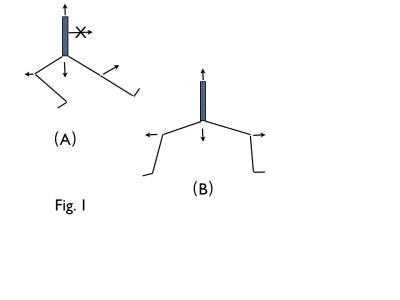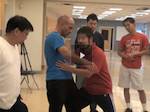There are some small details in stepping forward and finishing the form that I have been focusing while doing Yilu. I’d like to share here and hopefully generate some discussion.
In Practical Method, we first (1) shuffle one heel out when we step forward. Then (2) we move the knee forward and the body is shifted to center (roughly).
 Some people would do (1) and (2) together, so it really looks like stepping and weight shifting are done at the same time. It’s partly due to the weak supporting leg. With more practicing and increased leg strength, it can be easily corrected.
Some people would do (1) and (2) together, so it really looks like stepping and weight shifting are done at the same time. It’s partly due to the weak supporting leg. With more practicing and increased leg strength, it can be easily corrected.
What I want to point out is in step (2) after heel shuffling is done, how do we shift body weight to center? To make it more visually simple, I drew a match stick figure as in Fig. 1. We tend to move our body forward while push the knee forward. Unfortunately, this creates “double heavy.” (Two different body parts move in the same direction. Here, knee moves forward while the body moves forward also.)
As master Chen taught us that the body doesn’t “move” horizontally, it can “move” vertically. So, in Fig. 1 (A), while one knee is moving forward, the back knee should stay back, the tail bone drops and the head maintains upward push, the body will be adjusted to the central position.The body doesn’t actively push forward.
In push hand scenario, your upper body is blocked by the opponent, you step in. You only can do so (stepping-in) while your body is maintained motionless (don’t move). Then you need to adjust your body position to counter opponent’s push.
You cannot push your body into opponent’s body. That causes “ding (fighting).” You actually push the knee forward and your upper body is lowered and adjusted. This actually creates a wedge underneath you opponent. You then know what to do to finish the move.
When we are doing Yilu, often, we forget to finish each form as if we are in a hurry. I observed many beginners do that way, one form has not finished yet, the following form has already started. When I was a beginner years ago, Master Chen told me that I should give an extra push to expand in every finished form in Yilu. Here, I will use “Single Whip” as an example to explain what happens in legs in the finished form. 
In Fig. 2, the vertical lines in both (A) and (B) are the reference lines. In the finished bow stance or half horse stance, the front knee should be on top of the heel so the shin should be perpendicular to the ground. Usually our knee is off an inch or two to the vertical line, especially when you take a wide stance. No matter what stance you take, the front knee has to hit the vertical line. (A) and (B) show two different approaches. (A) is not the right way because the body moves toward the same direction. (B) is the right way. That’s the extra push I mentioned above.



{ 1 comment… read it below or add one }
Excellent analysis, Ping Wei!
One thing I heard Master Chen say at the recent New York workshop is that when shovel-stepping the front leg out, the rear kua must form a strong alignment with the rear knee. This not only keeps the body from tossing forward but also keeps the butt from protruding.